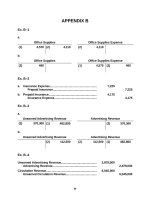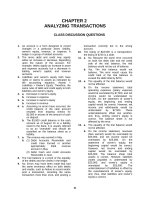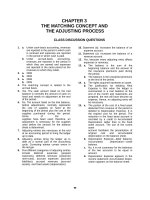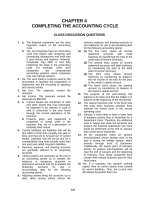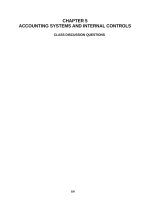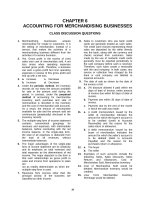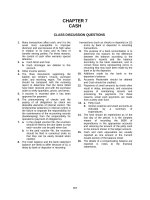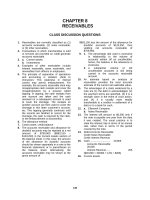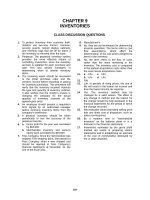Solution manual accounting 21e by warreni ch 14
Bạn đang xem bản rút gọn của tài liệu. Xem và tải ngay bản đầy đủ của tài liệu tại đây (155.33 KB, 40 trang )
CHAPTER 14
INCOME TAXES, UNUSUAL INCOME ITEMS, AND
INVESTMENTS IN STOCKS
CLASS DISCUSSION QUESTIONS
1. a. Current liability
b. Long-term liability or deferred credit
(following the Long-Term Liabilities
section)
2. This is an example of a fixed asset
impairment. Thus, a loss of $130 million
should be disclosed on the income
statement as a separate line item above
the income from continuing operations, and
the plant and equipment should be written
down to their appraised value ($20 million).
3. The severance costs are a current period
expense associated with downsizing
operations. Thus, a restructuring charge
should be recognized on the income
statement (above income from continuing
operations) and any liability recognized. As
payments are made to employees, the
liability is decreased.
4. Extraordinary items:
Gain on condemnation of land, net of
applicable income tax of $60,000...$90,000
5. The urban renewal agency’s acquisition of
the property may be viewed as a form of
expropriation under paragraph 23 of
Accounting Principles Board Opinion No.
30, Reporting the Results of Operations—
Reporting the Effects of Disposal of a
Segment of a Business, and Extraordinary,
Unusual and Infrequently Occurring Events
and Transactions. Paragraph 23 says a
gain or loss from sale or abandonment of
property, plant, or equipment used in the
business should be included as an
extraordinary item if it is the direct result of
an expropriation. Accordingly, the gain
should be reported as an extraordinary
item in the income statement.
6. The “loss from discontinued operations” of
$2.3 billion should be identified on the
income
statement
as
discontinued
operations
and
should
follow
the
presentation of the results of continuing
operations (sales less the customary costs
and expenses). The data on discontinued
operations (identity of the segment, date of
7.
8.
9.
10.
11.
12.
131
disposal, etc.) should be disclosed in a
note.
Readers of the financial statements should
be able to assume that the successive
financial statements of a business are
based consistently on the same generally
accepted accounting principles. Therefore,
significant changes in accounting methods
must be disclosed so that the reader is
alerted to the effect of those changes on
the financial statements.
a. Yes, the $0.45-per-share gain should
be reported as an extraordinary item.
b. Operations appear to have declined.
The earnings per share for the current
year that is comparable to the
preceding year’s earnings per share of
$1.10 is $0.93 ($1.38 – $0.45).
a. Examples of other comprehensive
income items include foreign currency
items, pension liability adjustments,
and unrealized gains and losses on
certain investments in debt and equity
securities.
b. No. Other comprehensive income does
not affect the determination of net
income or retained earnings.
A business may purchase stocks as a
means of earning a return (income) on excess cash that it does not need for its
normal operations. In other cases, a
business may purchase the stock of
another company as a means of
developing
or
maintaining
business
relationships with the other company. A
business may also purchase common
stock as a means of gaining control of
another company’s operations.
On
the
balance
sheet,
temporary
investments in marketable securities are
reported at their fair market values, net of
any applicable income taxes related to any
unrealized gains or losses.
Unrealized gains or losses (net of
applicable taxes) should be reported as
either an addition to or deduction from net
income in
income.
arriving
at
comprehensive
132
13. a. The equity method
b. Investments
14. Investment in Gestalt Corporation
15. a. Minority interest
b. Preceding stockholders' equity, usually
in the Long-Term Liabilities section.
16. Investment in
Affiliates................ 2,400,000
Income of
Affiliates.......
2,400,000
133
EXERCISES
Ex. 14–1
Apr.
15 Income Tax Expense...........................................
Cash................................................................
70,000
June 15 Income Tax Expense...........................................
Cash................................................................
70,000
Sept. 15 Income Tax Expense...........................................
Cash................................................................
70,000
Dec. 31 Income Tax Expense...........................................
Income Tax Payable.......................................
Deferred Income Tax Payable.......................
150,000*
70,000
70,000
70,000
40,000
110,000**
*[($900,000 × 40%) – (3 × $70,000)] = $150,000
**[($800,000 × 40%) – (3 × $70,000)] = $110,000
Jan.
15 Income Tax Payable............................................
Cash................................................................
110,000
110,000
Ex. 14–2
2005
Dec. 31 Income Tax Expense...........................................
Deferred Income Tax Payable.......................
Income Tax Payable.......................................
920,000
120,000*
800,000**
*$300,000 × 40% = $120,000
**$2,000,000 × 40% = $800,000
2006
Dec. 31 Income Tax Expense...........................................
Deferred Income Tax Payable.............................
Income Tax Payable.......................................
**$2,500,000 × 40% = $1,000,000
880,000
120,000
1,000,000**
Ex. 14–3
a.
Depreciation expense per year:
$100,000,0 00 $20,000,00 0
= $8,000,000 per year
10 years
December 31, 2006 net book value (carrying value) prior to impairment
adjustment:
Fiber optic network cost...........................................
Less accumulated depreciation................................
Fiber optic net book value........................................
$100,000,000
16,000,000
$ 84,000,000
b.
2006
Dec. 31 Loss from Fixed Asset Impairment....................
Fixed Assets—Fiber Optic Network..............
39,000,000*
39,000,000
*$84,000,000 – $45,000,000
c.
Balance sheet:
Fixed assets—Fiber optic network...........................
Less accumulated depreciation................................
Fixed assets—Fiber optic network net book value.
*$100,000,000 – $39,000,000
$61,000,000*
16,000,000
$ 45,000,000
Ex. 14–4
a.
2006
Dec. 31 Loss from Fixed Asset Impairment..................... 99,000,000
Fixed Assets—Buildings and Improvements
80,000,000
Fixed Assets—Land........................................
8,000,000
Fixed Assets—Equipment..............................
11,000,000
b. On December 31, 2006, management determined that one of the resort
properties was permanently impaired due to the discovery of an adjacent
toxic chemical waste site. Bookings to this property have dropped
significantly, and it was determined that the property had to abandoned. As a
result, a $99 million asset impairment loss was recognized in 2006, reflecting
the fair value of assets associated with this site, as detailed in the following
table:
Buildings and improvements.......................................
Land...............................................................................
Equipment......................................................................
Total impairment........................................................
$80,000,000
8,000,000
11,000,000
$ 99,000,000
Ex. 14–5
a.
2006
Nov.
1 Restructuring Charge.........................................
Employee Termination Obligation................
3,600,000
3,600,000
Average salary.....................................................................................
Planned number of positions eliminated..........................................
Total annual salary eliminated......................................................
Average tenure....................................................................................
Severance rate....................................................................................
Total severance..............................................................................
$
60,000
×
150
$ 9,000,000
×
8 yrs.
×
5%
$ 3,600,000
b.
2006
Dec. 15 Employee Termination Obligation......................
Cash................................................................
960,000
Average salary.....................................................................................
Number of positions eliminated.........................................................
Average tenure....................................................................................
Severance rate....................................................................................
Total severance..............................................................................
960,000
$ 60,000
×
40
× 8 yrs.
×
5%
$960,000
c.
Balance sheet disclosure:
Current liabilities:
Employee termination obligation
$2,640,000
Note disclosure:
On November 1, 2006, the board of directors approved a plan to eliminate 150
headquarter positions due to a decline in demand for the company’s products. A
severance plan was approved and communicated to employees providing
termination benefits to employees terminated between December 1, 2006, and
April 1, 2007. Accordingly, a restructuring charge of $3,600,000 was recognized in
2006 for the accrued termination benefits. Of this amount, $960,000 was
distributed to terminated employees in 2006. The remaining $2,640,000 was
recognized as a current liability and will be paid to employees terminated during
the first three months of 2007.
Ex. 14–6
a.
Closing and relocation costs
Employee severance costs
Contract termination costs
Total restructuring charge
$
500,000
2,419,200*
120,000
$ 3,039,200
*Employee severance costs:
Number of hours per month
Labor rate per hour
Monthly wage per employee
Number of employees
Total monthly wages
Severance rate
Total termination benefit
180 hrs.
×
$12.00
$
2,160
×
280
$ 604,800
×
400%
$ 2,419,200
b.
2006
July
1 Restructuring Charge.........................................
Restructuring Obligation...............................
3,039,200
3,039,200
Note: The obligation is not “employee termination obligation” because there are
several types of restructuring charges included in the total. Thus, the account
Restructuring Obligation is used to represent the total obligation.
c.
2006
Oct. 15 Restructuring Obligation....................................
Cash................................................................
604,800
$604,800 = $2,419,200 ÷ 4
d. Balance sheet disclosure:
Current liability:
Restructuring obligation
$1,814,400
$1,814,400 = $604,800 × 3 remaining installments
Note: All other estimated restructuring payments were made in 2006.
604,800
Ex. 14–6
(Concluded)
e. Note disclosure:
On July 1, 2006, the board of directors of the company approved and
announced a restructuring plan that resulted in a $3,039,200 charge in 2006
consisting of the following items:
Closing and relocation costs
Employee severance costs
Contract termination costs
Total restructuring charge
$
500,000
2,419,200
120,000
$ 3,039,200
The restructuring was caused by unfavorable publicity regarding the caffeine
content of our juice products. The adverse publicity reduced the demand for
our products, requiring us to consolidate operations by closing one of our
juice plants and eliminating 280 direct labor positions. On December 31, 2006,
there remains a current restructuring obligation of $1,814,400, primarily
related to employee severance agreements.
Note: While no information was provided in the exercise, it is likely that the
factory building is also impaired requiring a write-down and appropriate
disclosures.
Ex. 14–7
a.
2006
Dec. 31 Loss from Fixed Asset Impairment....................
Fixed Assets—Tractor-Trailers.....................
15,000,000*
15,000,000
*($34,000,000 – $9,000,000) × 60%
Dec. 31 Restructuring Charge.........................................
Employee Termination Obligation................
650,000*
650,000
*65 employees × $10,000
b. December 31, 2006 balance sheet disclosures:
Fixed assets:
Tractor-trailers..............................................................................
Less accumulated depreciation..................................................
Tractor-trailer net book value......................................................
$19,000,000
(9,000,000)
$10,000,000
Current liabilities:
Employee termination obligation................................................
$650,000
Note:
On December 31, 2006, the board of directors approved and communicated a
restructuring plan in response to low-cost competition in the company’s
service market. The plan calls for the sale of 50 tractor-trailers and elimination
of 50 drivers and 15 staff personnel. Due to the general overcapacity in the
transportation market, tractor-trailer market values are estimated to be 40% of
the existing book value, causing us to recognize an unrecoverable loss on
fixed asset impairment of $15,000,000 in 2006 for the entire fleet. In addition, a
severance plan was approved for the eliminated positions. The charge for
employee severance was $650,000 for 2006, all of which is currently payable
at the end of the fiscal year. It is estimated that all severance obligations will
be satisfied by the end of the first quarter in 2007.
c.
2007
Mar. 14 Employee Termination Obligation......................
Cash................................................................
650,000
650,000
Ex. 14–8
a.
Special Charges............................................................
Fixed Assets—Property, Plant, and Equipment....
Employee Termination Obligation..........................
32,755,000
Accrued Liabilities.......................................................
Cash.........................................................................
4,629,000
28,627,000
4,128,000
b.
4,629,000
c. Balance sheet:
Current liabilities:
Accrued liabilities
$4,110,000*
*$6,903,000 + $4,128,000 – $4,629,000 – $2,292,000
Note: The noncash utilization of the employee severance was not described
in the notes, but it could include pension, health, or other employee benefit
increases. In addition, employee benefit obligations would be included with
other accrued liabilities on the balance sheet.
Ex. 14–9
No. Extraordinary items are events and transactions that are unusual and occur
infrequently. It is not unusual for a company to insure the life of its president or
to receive the proceeds of the policy upon his or her death. Since it does not
meet both criteria, this gain is not an extraordinary item.
Ex. 14–10
To be classified as an extraordinary item for income statement reporting
purposes, the item (event) must be (1) unusual from the typical operating
activities of the business and (2) occurring infrequently. Although it would seem
that the income from the Stabilization Act would meet these criteria, the airline
industry (including Delta) did not report the income as an extraordinary item.
Indeed, the complete costs and income from the September 11, 2001 terrorist
incident were not accounted for as extraordinary items as explained below.
The text from the Emerging Issues Task Force, “Accounting for the Impact of the
Terrorist Attacks of September 11, 2001,” explains the reason for the decision:
The EITF reached a consensus that losses or costs resulting from the September
11 events should be included in the determination of income from continuing
operations; thus, they should not be classified as extraordinary items. In the
opinion of the Task Force, it would not be possible to isolate the effects of the
September 11 events in a single line item, because of the difficulty in
distinguishing losses that are directly attributable to such events from those that
are not. Losses or costs associated with the events of September 11 may,
however, be reported as a separate component of income from continuing
operations if they are deemed to be either unusual or infrequently occurring in
nature.
In the final analysis, the Task Force reached the foregoing decision based on its
conclusion that users of financial statements would not be well served by
separate reporting as an extraordinary item of only a portion of the impact of the
September 11 events that strictly qualify for extraordinary classification under
APB No. 30, Reporting the Results of Operations. Pursuant to Opinion 30, only
losses or costs that can be clearly measured and irrefutably attributed to a
specific event may be shown as an extraordinary item.
The Task Force acknowledges that, while the September 11 events no doubt
contributed to the pace and severity of the economic slowdown, identifying the
impact of those events would be subjective and difficult—if at all possible.
Moreover, the Task Force points out that the most significant financial statement
impact for many affected companies might be lost or reduced revenues; in
accordance with Opinion 30, the measurement of an extraordinary item does not
reflect an estimate of forgone sales or income.
Ex. 14–11
a.
b.
c.
d.
NR
NR
NR
NR
e.
f.
g.
h.
E
NR
E
NR
Ex. 14–12
WAVE RUNNER, INC.
Income Statement
For the Year Ended June 30, 2006
Sales...................................................................................
Cost of merchandise sold.................................................
Gross profit........................................................................
Operating expenses:
Selling expenses.........................................................
Administrative expenses............................................
Other expenses:
Fixed asset impairment..............................................
Restructuring charge.................................................
Income from continuing operations before income tax
Income tax expense...........................................................
Income from continuing operations.................................
Loss on discontinued operations, net of applicable
income tax of $36,000.................................................
Income before extraordinary item and cumulative
effect of a change in accounting principle................
Extraordinary item:
Gain on condemnation of land, net of applicable
income tax of $17,200.............................................
Less cumulative effect on prior years of changing to a
different depreciation method, net of applicable
income tax reduction of $24,000...............................
Net income.........................................................................
Earnings per common share:
Income from continuing operations..........................
Loss on discontinued operations..............................
Income before extraordinary item and cumulative
effect of a change in accounting principle............
Extraordinary item......................................................
Less cumulative effect on prior years of changing
to a different depreciation method........................
Net income..................................................................
$976,400
431,900
$544,500
$125,100
92,400
217,500
100,000
80,000
$147,000
58,800
$ 88,200
54,000
$ 34,200
25,800
(36,000)
$ 24,000
$
8.82
5.40
$
3.42
2.58
$
(3.60)
2.40
Ex. 14–13
1.
2.
3.
4.
5.
6.
The order of presentation of the unusual items is incorrect. The order should
be as follows:
Income from continuing operations
Loss on discontinued operations
Income before extraordinary items and cumulative effect of a change in
accounting method
Extraordinary item
Cumulative effect of change in accounting method
Net income
The restructuring charge is not an extraordinary item but should be disclosed
above income from continuing operations. The associated tax benefit should
not be net against this amount but should be part of the tax on continuing
operations.
The fixed asset impairment should be disclosed above income from
continuing operations.
The earnings per share data are presented in the incorrect order—see (1)
above.
The earnings per share computations are incorrect. The amount of preferred
stock dividends ($20,000) should be subtracted from “income from
continuing operations,” “income before extraordinary item and cumulative
effect of change in accounting principle,” and “net income” in computing the
earnings per share of common stock.
A corrected presentation appears on the next page.
Ex. 14–13
(Concluded)
AUDIO AFFECTION, INC.
Income Statement
For the Year Ended December 31, 2006
Net sales.............................................................................
Cost of merchandise sold.................................................
Gross profit........................................................................
Operating expenses:
Selling expenses.........................................................
Administrative expenses............................................
Special charges:
Restructuring charge.................................................
Fixed asset impairment..............................................
Income from continuing operations before income tax
Income tax expense...........................................................
Income from continuing operations.................................
Loss on discontinued operations (net of applicable
income tax of $76,000)...............................................
Income before extraordinary items and cumulative effect
of change in accounting method...............................
Extraordinary item:
Gain on condemnation of land, net of applicable
income tax of $80,000.............................................
Cumulative effect on prior years’ income (decrease) of
changing to a different depreciation method (net of
applicable income tax reduction of $86,000)............
Net income.........................................................................
Earnings per common share:
Income from continuing operations
[($700,500 – $20,000) ÷ 50,000 shares]..................
Loss on discontinued operations..............................
Income before extraordinary item and cumulative
effect of change in accounting principle...............
Extraordinary item......................................................
Cumulative effect on prior years’ income (decrease)
of changing to a different depreciation method. . .
Net income..................................................................
*$420,000 – $25,500 tax benefit from restructuring charge
$ 9,450,000
7,100,000
$ 2,350,000
$820,000
320,000
$ 85,000
30,000
1,140,000
115,000
$ 1,095,000
394,500*
$ 700,500
(184,000)
$
516,500
120,000
(204,000)
$
432,500
$
13.61
(3.68)
$
9.93
2.40
(4.08)
$
8.25
Ex. 14–14
Basic earnings per share when there is preferred stock is determined as,
Earnings per Common Share =
Net Income - Preferred Stock Dividends
Number of Common Shares Outstanding
Earnings per Common Share =
$740,000 - (50,000 pref. shares $6 per share)
125,000 common shares
Earnings per Common Share = $3.52 per share
Ex. 14–15
a.
Other comprehensive income (in millions):
Foreign currency translation.....................................
Net investment hedges,
net of $238 tax benefit............................................
Other, net of tax benefit..............................................
Total other comprehensive income (loss)................
$ 263
(397)
(106)
$(240)
b. Percentage decline in net income due to other comprehensive losses:
$240
= 5.5%
$4,352
c. (1) Retained earnings: $11,980 = $10,451 + $4,352 – $2,823
(2) Accumulated other comprehensive loss: ($2,360) = ($240) – ($2,120)
Ex. 14–16
a.
b.
c.
d.
e.
f.
g.
h.
$40,000
$(3,000)
$37,000
$23,000
$38,000
$25,000
$216,000
$(6,000)
$180,000 – $140,000
$8,000 – $5,000
$40,000 – $3,000
$26,000 – $3,000
$36,000 + $2,000
$23,000 + $2,000
$180,000 + $36,000
–$8,000 + $2,000
Ex. 14–17
a.
COSBY CORPORATION
Statement of Comprehensive Income
For the Year Ended December 31, 2006
Net income..................................................................
Other comprehensive income:
Unrealized gain on investment portfolio, net of tax.
Total comprehensive income.................................
$145,000
40,000
$185,000
b.
COSBY CORPORATION
Stockholders’ Equity
December 31, 2006
Common stock............................................................
Paid-in capital in excess of par value........................
Retained earnings.......................................................
Accumulated other comprehensive loss..................
Total.........................................................................
*$435,000 + $145,000
**($60,000) + $40,000
$ 35,000
350,000
580,000*
(20,000)**
$945,000
Ex. 14–18
a.
2006
Unrealized loss [10,000 shares × ($20 – $17)]...........
Less tax benefit on unrealized loss (40% rate).........
Unrealized loss, net of income tax benefit................
$30,000
12,000
$18,000
2007
Unrealized gain [10,000 shares × ($27 – $17)]...........
Less taxes on unrealized gain (40% rate)................
Unrealized gain, net of income tax............................
$10,000
40,000
$60,000
Note: The tax benefit and expense give rise to temporary differences, since
gains and losses are only included for tax purposes at the time of sale.
b.
Dec. 31, 2006
Other Accumulated Comprehensive Loss
$18,000
Dec. 31, 2007
Other Accumulated Comprehensive Income
$42,000*
*($18,000) + $60,000 = $40,000
c. The Other Accumulated Comprehensive Income or Deficit is disclosed in the
stockholders’ equity section of the balance sheet, separately from the
retained earnings or paid-in capital accounts.
Ex. 14–19
a.
Marketable Securities....................................................
Cash ..............................................................................
74,000
74,000
b. Cash................................................................................
Dividend Revenue.........................................................
2,500
2,500
Ex. 14–20
a.
LYON RESEARCH CORPORATION
Balance Sheet
December 31, 2006
Assets
Current assets:
Temporary investments in marketable securities,
at cost......................................................................
Less unrealized loss (net of applicable income
tax benefit of $4,400)..............................................
$74,000
6,600*
*Computation:
Market:
M-Labs, Inc.: 1,000 shares × $28............................
Spectrum Corp.: 2,500 shares × $14......................
Cost ($29,000 + $45,000)............................................
Unrealized loss...........................................................
Taxes on unrealized loss ($11,000 × 40%).................
Unrealized loss, net of applicable tax benefit...........
$67,400
$ 28,000
35,000
$ 63,000
74,000
$ (11,000)
4,400
$ (6,600)
b.
LYON RESEARCH CORPORATION
Statement of Comprehensive Income
For the Year Ended December 31, 2006
Net income..........................................................................................
Other comprehensive loss:
Unrealized loss on temporary investments in marketable
securities (net of applicable income tax benefit of $4,400)........
Comprehensive income......................................................................
$ 80,000
(6,600)
$ 73,400
Ex. 14–21
a.
Investment in Beach Co. Stock.....................................
Cash ..............................................................................
122,400
122,400
b. Cash................................................................................
Dividend Revenue.........................................................
(No entry for stock dividends; carrying
amount per share of stock is now
$122,400 ÷ 3,060, or $40.)
4,500
c.
Cash................................................................................
Investment in Beach Co. Stock.....................................
Gain on Sale of Investments.........................................
4,500
48,940
40,000
8,940
Ex. 14–22
a.
Investment in Caleb Corp. Stock..................................
Income of Caleb Corp....................................................
($2,500,000 × 70,000/280,000)
625,000
b. Cash................................................................................
Investment in Caleb Corp. Stock..................................
(70,000 shares × $3.40)
238,000
625,000
238,000
Ex. 14–23
a.
Investment in Toys-Japan Feb. 3, 2001.....................
Plus equity in net earnings of Toys-Japan................
Less dividends received or common stock sale......
Investment in Toys-Japan Feb. 2, 2002.....................
$108
29
(14)*
$123
*Since the ending balance in the investment in Toys-Japan account is not
equal to the beginning balance plus the equity earnings, there must be some
explanation for the $14 million reduction. The two best explanations are a
dividend by Toys-Japan to Toys “R” Us, which would reduce the investment
account, or an outright sale of common stock, which would also reduce the
investment. This exercise asks the student to identify these two possibilities.
How could we determine which explanation is the correct one? Although not
required in this exercise, the statement of cash flows will show if there are
any investment activities from sale of common stock, or whether there were
dividends received from the investee.
Ex. 14–23
(Concluded)
b. The Investment in Toys-Japan is not recognized at market value because Toys
“R” Us has significant influence over the investee, by having an investment
that exceeds 20% of the outstanding common stock of Toys-Japan. When the
investor holds significant influence, the equity method is applied, rather than
market value accounting. One reason for this is because such large
percentage holdings in a company may not be easily sold at the market price
shown in the secondary market.
Ex. 14–24
a.
(1)
$45,000
Consolidated sales should be $966,000 ($845,000 + $166,000 – $45,000).
(2)
$45,000
Consolidated cost of merchandise sold should be $413,000 ($390,000 +
$68,000 – $45,000).
b. Consolidated net income can be determined as follows:
Sales [from a. (1)]........................................................
Cost of merchandise sold [from a. (2)].....................
Selling expenses.........................................................
Administrative expense..............................................
Net income..................................................................
$966,000
413,000
159,000
103,000
$291,000
Note: The interest revenue and interest expense should also be eliminated from
the consolidated numbers.
Ex. 14–25
Price-Earnings Ratio =
a.
Market Price per Share of Common Stock
Earnings per Share of Common Stock (basic)
Price-earnings ratio, Jan. 28, 2001:
55.83
($16.75/$0.30)
Price-earnings ratio, Feb. 3, 2002:
76.33
($37.40/$0.49)
Price-earnings ratio, Feb. 2, 2003:
49.85
($30.41/0.6)
Ex. 14–25
Concluded
b. The price-earnings ratio increased in 2002 from 55.83 to 76.33, then declined
to 49.85 by the end of fiscal 2003. These price-earnings ratios are over twice
the average ratios of the overall market. This indicates that investors are
optimistic about the prospects for this company. They expect strong earnings
growth and have priced this expectation into the common stock. That is,
investors are attracted to the common stock, and this has caused the priceearnings ratio to remain high. The doubling of earnings per share from 2001
to 2003 provides some evidence for this optimism. The stock price has begun
to settle, allowing the earnings to “catch up” to the price, thus causing the
price-earnings ratio to decline in 2003. Krispy Kreme’s price-earnings ratio
should also be compared with its industry competitors to assess how the
market expects Krispy Kreme to perform relative to the market.
c. The diluted earnings per share includes the impact of potentially dilutive
securities, such as convertible preferred stock, options, warrants, and
contingently issuable shares.
Ex. 14–26
a.
Price-Earnings Ratio =
Market Price per Share of Common Stock
Earnings per Share of Common Stock (basic)
Price-earnings ratio, 2002:
$35
, 20.71
$1.69
Price-earnings ratio, 2001:
$39
, 17.49
$2.23
Price-earnings ratio, 2000:
$42
, 16.47
$2.55
b. The price-earnings ratio grew by nearly 26% from 2000 to 2002. During this
time, the overall stock market was declining, and the economy was headed
for a recession. In the case of ExxonMobil, earnings per share fell by 34%,
while the stock price dropped only 17%. Thus, the price-earnings ratio
expanded. Market participants believe that the decline in earnings is not a
trend; thus, the market price has not fallen proportionately. Apparently, market
participants believe the stock price will increase in the future, thus increasing
the price-earnings ratio over this time period. This expectation may be
warranted due to the company’s sensitivity to oil prices.
PROBLEMS
Prob. 14–1A
1. and 2.
Deferred Income
Tax Payable
Year
First
Second
Third
Fourth
Total
Income Tax
Deducted
on Income
Statement
Income Tax
Payments for
the Year
Year's Addition
(Deduction)
$ 80,000
96,000
120,000
160,000
$456,000
$ 60,000
92,000
128,000
170,000
$450,000
$ 20,000
4,000
(8,000)
(10,000)
$ 6,000
Year-End
Balance
$20,000
24,000
16,000
6,000
Prob. 14–2A
MOTOSPORT INC.
Income Statement
For the Year Ended October 31, 2006
Sales...................................................................
Cost of merchandise sold.................................
Gross profit........................................................
Operating expenses:
Selling expenses:
Sales salaries expense..............................
Advertising expense..................................
Depreciation expense—store equipment.
Store supplies expense.............................
Miscellaneous selling expense.................
Total selling expenses............................
Administrative expenses:
Office salaries expense.............................
Rent expense.............................................
Depreciation expense—office equipment
Miscellaneous administrative expense....
Total administrative expenses................
Total operating expenses..................................
Income from continuing operations before
other items.....................................................
Other income, expenses, and special charges:
Interest revenue.............................................
Loss from fixed asset impairment................
Restructuring charge.....................................
Income from continuing operations before
income tax......................................................
Income tax expense...........................................
Income from continuing operations.................
Loss from discontinued operations...................
Less applicable income tax...............................
Income before extraordinary item....................
Extraordinary item:
Gain on condemnation of land......................
Less applicable income tax...........................
Net income.........................................................
Earnings per share:
Income from continuing operations.............
Loss on discontinued operations.................
Income before extraordinary item................
Extraordinary item.........................................
Net income.....................................................
$1,350,000
612,400
$ 737,600
$140,000
64,000
23,000
6,500
5,500
$ 75,000
24,000
7,000
12,000
$239,000
118,000
357,000
$ 380,600
12,000
(110,000)
(14,000)
$ 31,000
12,000
$ 36,400
13,400
$ 268,600
92,500
$ 176,100
(19,000)
$ 157,100
23,000
$ 180,100
$
$
$
7.04
(0.76)
6.28
0.92
7.20
Note: Unrealized loss on temporary investments would be an other comprehensive
income item, not included on the income statement in determining net income.
